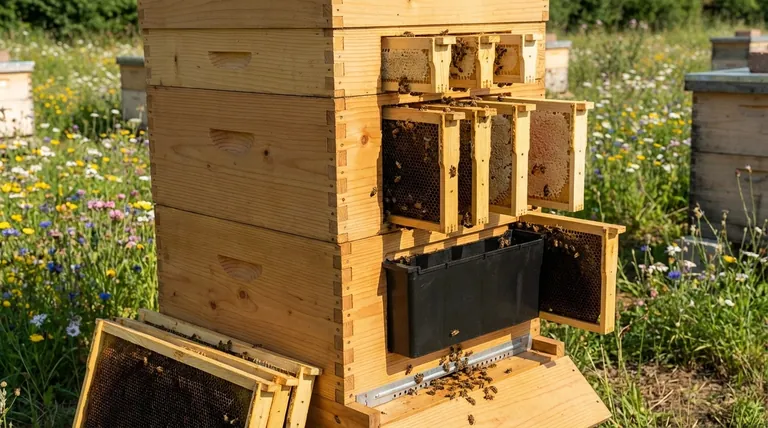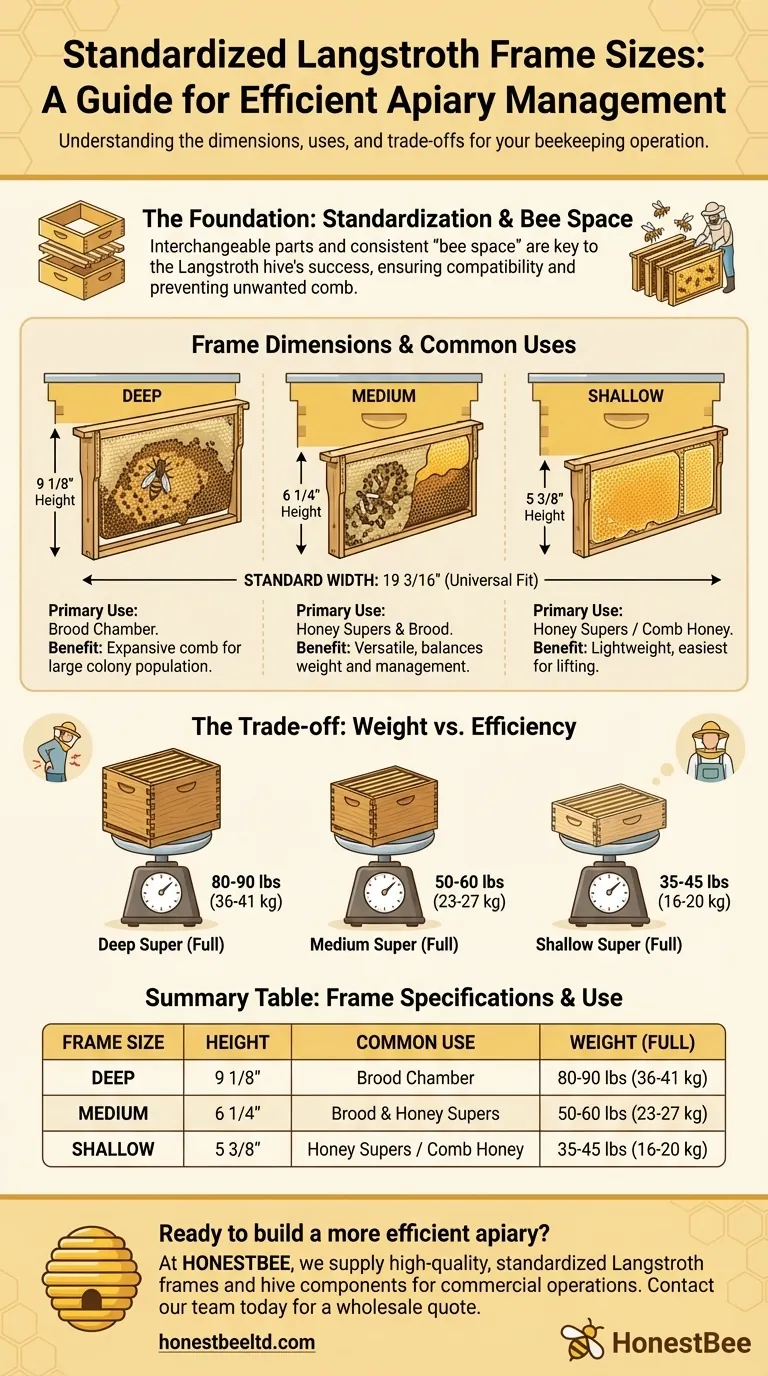The standardized sizes for Langstroth frames are defined by their height, with all standard frames sharing a uniform width. There are three official sizes: Deep frames are 9 1/8″ tall, Medium frames are 6 1/4″ tall, and Shallow frames are 5 3/8″ tall. All three sizes have a standard width of 19 3/16″ to ensure they fit correctly within a standard Langstroth hive body.
The choice of frame size is the most fundamental equipment decision a beekeeper makes. It directly dictates the weight of your hive boxes and your entire approach to hive management, from inspections to honey harvesting.

The Purpose of Standardized Sizing
The genius of the Langstroth hive, which revolutionized modern beekeeping, is its system of interchangeable parts. Standardization allows beekeepers to easily swap frames between different boxes, combine hives, or purchase new equipment with the confidence that it will be compatible.
This system is built around the concept of "bee space," ensuring that bees have just enough room to work without building unwanted comb that connects frames and makes inspections impossible. The consistent width and precise heights of the frames are critical to maintaining this space.
Decoding the Three Standard Frame Sizes
While the width is constant, the three different heights serve distinct and strategic purposes within the hive.
Deep Frames (9 1/8″) - The Brood Chamber
Deep frames are the largest standard size and are most commonly used in the lower boxes of the hive, known as the brood chamber.
Their large surface area provides the queen with an expansive, unbroken comb to lay her eggs in a natural pattern. This helps promote a large, healthy colony population.
Medium Frames (6 1/4″) - The Versatile Workhorse
Medium frames are often considered the most versatile option. Their most common use is in honey supers—the boxes stacked on top of the brood chamber where bees store surplus honey.
Because they are smaller and lighter than deeps, many beekeepers choose to standardize their entire operation on medium frames, using them for both the brood chamber and honey supers. This simplifies equipment management, as all frames are interchangeable.
Shallow Frames (5 3/8″) - The Honey Specialist
Shallow frames are the smallest and lightest option. They are used almost exclusively for honey supers.
Their primary advantage is their light weight when full of honey, making them the easiest to lift. They are also favored by beekeepers who specialize in producing comb honey, as the smaller frame size is ideal for this purpose.
Universal Width (19 3/16″) - The Constant
The constant width ensures that every frame, regardless of its height, will hang correctly inside any standard Langstroth hive body. The top bar rests on the rabbet edge of the box, creating the correct spacing for the bees to work efficiently.
Understanding the Trade-offs: Weight vs. Efficiency
Your choice of frame size involves a direct trade-off between the natural efficiency of the hive and the physical demands placed on the beekeeper.
The Weight Factor
The most significant consideration is weight. A box full of honey is deceptively heavy, and this is where frame size makes a dramatic difference.
- A deep super full of honey can weigh 80-90 pounds (36-41 kg).
- A medium super full of honey weighs around 50-60 pounds (23-27 kg).
- A shallow super full of honey weighs around 35-45 pounds (16-20 kg).
Lifting an 80-pound box from a hive can be a significant physical challenge, which is why deeps are rarely used for honey supers.
The Management Factor
Using a mix of sizes (deeps for brood, mediums for honey) is a very common and effective strategy. It gives the queen a large brood nest while keeping the honey boxes at a manageable weight.
However, running an entire apiary on a single size, typically mediums, offers the ultimate simplicity. Every frame fits in every box, streamlining inspections and equipment inventory. The trade-off is that the queen's brood nest will be split across two or more boxes.
How to Choose the Right Frame Size for Your Apiary
Select your equipment based on your physical ability, management style, and beekeeping goals.
- If your primary focus is a large, uninterrupted brood nest: Use deep frames for your brood boxes to give the queen an expansive laying area.
- If your primary focus is minimizing physical strain and simplifying equipment: Standardize your entire hive on medium frames for both brood and honey supers.
- If your primary focus is producing comb honey or having the lightest possible boxes: Use shallow frames exclusively for your honey supers.
Ultimately, understanding these standardized dimensions empowers you to build a hive that works best for both your bees and you.
Summary Table:
| Frame Size | Height | Common Use | Weight (Full of Honey) |
|---|---|---|---|
| Deep | 9 1/8" | Brood Chamber | 80-90 lbs (36-41 kg) |
| Medium | 6 1/4" | Brood & Honey Supers | 50-60 lbs (23-27 kg) |
| Shallow | 5 3/8" | Honey Supers / Comb Honey | 35-45 lbs (16-20 kg) |
| All frames share a standard width of 19 3/16" for universal compatibility. |
Ready to build a more efficient and manageable apiary?
At HONESTBEE, we supply commercial apiaries and equipment distributors with high-quality, standardized Langstroth frames and hive components. Our wholesale-focused operations ensure you get the reliable, compatible equipment you need to optimize your hive management and honey production.
Contact our team today to discuss your specific needs and get a quote for your operation.
Visual Guide

Related Products
- Professional In-Hive Bee Feeder HONESTBEE Frame for Beekeeping
- Plastic Bee Frame Beekeeping Hive Frames for Wholesale
- Mini Desktop Bee Hive Frame Forming Making Machine
- JZBZ Langstroth Queen Rearing Frame for Beekeeping
- HONESTBEE Wired and Assembled Wooden Bee Frames Foundation for a Thriving Hive
People Also Ask
- Are frame feeders good? Maximize Your Hive's Health with the Right Feeding Strategy
- How does the design of Langstroth frames make them easier to operate? Leverage Bee Space for Efficient Hive Management
- What is a frame feeder and how does it work? An Efficient In-Hive Feeding Solution
- What are the standard dimensions for Langstroth beehive frames? Choose the Right Size for Your Apiary
- How do you feed bees outside the hive? Understanding the Risks and Safe Alternatives



















